The 338 Winchester Magnum is perhaps the most versatile of the so-called “all-around” rifle cartridges for North American hunting. The caliber is less intimidating than the physically longer 375 H&H, though it has similar performance. The 338 can be flatter shooting than the 375 with careful choice of loads, and also carries its power to long distance well, thanks to the great sectional density of its more useful bullet weights. A 375 commonly shoots 235- to 300-grain bullets, and bullets in that weight range are readily available in 338, at least for reloaders. The 338 bullets are slimmer, and therefore retain their velocity better, even though they might start at slightly lower speeds. The 338 can be fitted into shorter and less costly actions, which is why so many shooters choose the 338 over the 375. And the 338 will do things 30-caliber rifles only dream about, having a significantly greater amount of power at any range.
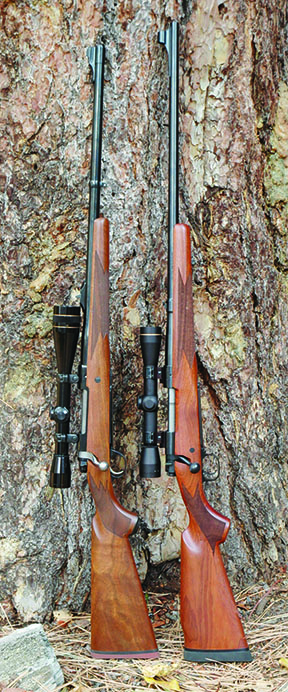
For this test we look at two of the currently available 338s that come with iron sights. We found there are not many of those on the market. The Winchester Model 70 Alaskan ($1270) and the Ruger Model 77 Hawkeye ($1099) were our choices. We tested them with Remington 225-grain Core-Lokt, Hornady 225-grain SN, and with a handload featuring the 210-grain Barnes X bullet. Here’s what we found.
Winchester Model 70 Alaskan 338 Win. Mag, $1270
We liked this rifle a lot. However, although the Winchester 338 is built on the long action, same length as used on the 375, for some silly reason the factory puts an aluminum trigger guard on this rifle. The floor plate is steel. Did not Winchester learn anything from Ruger? Long ago Ruger put aluminum trigger guards and floor plates on its M77 rifles, but after many complaints they went to steel, which they are today. Steel trigger guards are indeed mounted on the $150 more expensive Winchester Safari rifles. We don’t believe a steel guard could add that much to the price over this aluminum one, but we do believe the bottom metal on a serious bolt rifle needs to be all steel.
The next thing we didn’t like was the free-floated barrel. The well-checkered stock felt unsupported, and vibrated easily in the breeze between the barrel and the wood. That gave the rifle a cheap feel. If we owned this one we’d immediately full-length glass-bed it in Brownells’ Steel Bed, with some upward pressure on the barrel. However, the rifle shot very well as it was, and some shooters like such a setup. We don’t. The stock was decent walnut, with a hump on the butt that resembled a Monte Carlo, but wasn’t. There was no cheekpiece. The stock was reminiscent of older Model 70s, so there’s a precedent for this stock design. The simple rear sight was mounted on the famous Model 70 hump on the barrel, with adjustments for elevation with tiny screws and for windage by drifting. There may be enough metal under the hump to install a third screw, which would bind the metal to the wood even more securely, along with our proposed glass bedding. The front sight was a large brass bead, flat faced, protected by a stout hood. We did a simple trick to the rear sight that you might want to try. We flipped over the little insert and filed a V into the side opposite the U, and sighted the rifle in with our new “express” sight. We found that the V worked much better with the large front bead than the foolish U-notch on the other end of the insert.
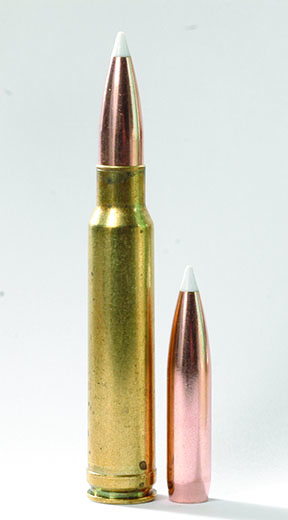
We liked the checkering, the nice buttpad, the iron sights, the lovely and long 25-inch barrel, the stock finish, and the metal finish all very much. Nice job, Winchester. The bolt was the old cone-breech, controlled-feed type with checkering on the bolt knob. The bolt worked mighty slick in the action. There were no flaws in the metal or woodwork. We folded the rear sight out of the way and mounted a new Leupold FX II 4-power scope (#58550) in Weaver rings and bases, and took the Winchester to the range.
The rifle shot very well. Most of our groups were in the 1- to 1.5-inch range at 100 yards for three shots. At press time we didn’t yet have any heavy bullets to try, but with the Winchester’s 1:10 twist we suspect they’ll shoot just as well as, or better than, the light ones that the rifle liked so well. The 25-inch barrel gave significantly higher velocities than the 23-inch Ruger tube. This amounted to 50, 60, and 80 fps with the three ammos tried. Kudos to Winchester for sticking this uncommonly long tube on a rifle where it definitely belongs. The barrel was slim enough to retain good balance and liveliness, we thought. Yet the rifle was comfortable to shoot off the bench, thanks to the excellent recoil pad. There were no problems with feed, ignition, or ejection. The trigger was just a touch heavier than we liked, but clean. And it’s adjustable, so no problems there. It looked like the steel trigger guard from the 375 Model 70 African would fit this Alaskan model perfectly, and you’d have to get the proper floor plate too, and maybe the inner mag box. The only problem might be getting the factory to turn these parts loose. We called for a quote but never heard back.
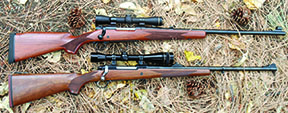
Our Team Said: We found the Winchester to be easier feeding, half a pound lighter, somewhat more attractive, and definitely more accurate than the Ruger with the three loads tried. We had to go looking for flaws, and have already noted some items we don’t like, specifically the aluminum trigger guard, the free-floating stock, and no cheekpiece, which would reduce the facial recoil. Everything else was top notch, we thought. Because of our few dislikes, we gave this an A-minus grade.
Ruger M77 Hawkeye HM77RS Model No. 37152 338 Win. Mag., $1099
The Hawkeye had a decent chunk of walnut carved into an excellent stock design, with excellent checkering that wrapped the forend and had generous panels on the wrists. The stock finish was matte, like that on the Winchester, and also like the M70, filled the pores perfectly. The steel floorplate had a tasteful Ruger logo cut into it. The forend sling swivel was mounted on the barrel with a band, and the front sight was also a band encircling the 23-inch tube. There was no protection for the large white front bead. Although the barrel was free floated, the stock had warped to the side, giving no clearance on the left side of the barrel. There was no significant upward pressure on the barrel either, which we suspect led to the mediocre accuracy of this rifle. Maybe Winchester had the right idea, leaving a huge gap between the barrel and the wood.
The Ruger had the same 1:10-inch twist as the Winchester. The iron sights were a V-notch rear, which was easily adjustable for windage by loosening a lock screw; and the large white-beaded front. We thought the V of the sight could have been shallower and would have worked just as well, or even better than it did. We had to move the rear sight to the right a bunch to get the iron sights centered. Then we installed another of our selection of older scopes to see how well it would work on this new rifle. Readers may recall we had an ancient Weaver K2.5 with post on the Winchester 375 M70 tested recently, and it gave us splendid small groups and held up well. This time we put on an old K4 Weaver, bought on eBay just for this test. However, the scope lasted half a dozen shots and then the objective retention ring blew out and we had to change scopes. We stuck on our trusty 12x Leupold and proceeded with our test.
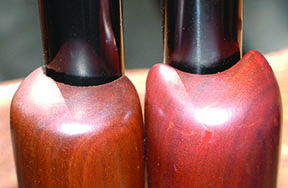
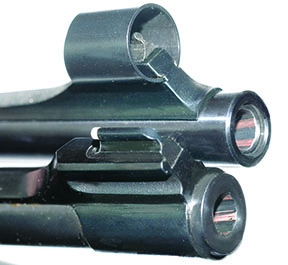
As noted, Ruger put the forward sling swivel onto the barrel, and we thank them for that. The Winchester had it on the stock, and while some will want to use a sling with the rifle and will welcome the placement of the Winchester’s forward swivel stud, we got bit several times by it shooting from the bench. We’d prefer it on the barrel, like Ruger has it. The excellent checkering helped keep our hands in place. Although the bolt was extremely slick, just as good as the Winchester’s, feeding from the magazine was not quite as positive. Twice we had a “click” when we failed to pick up the second round from the magazine. Our slow working of the bolt may have been part of the problem here, but the rounds didn’t want to come out of the magazine easily. We could not duplicate this after our shooting tests, so perhaps a few burrs in the magazine got ironed out. The edges of the rails were very sharp, and the brass may have stuck on them to some extent. Ejection was strong.
The Ruger was not a tack driver. The smallest group we fired with it was 1.2 inches with the hot Hornady ammo, but most groups were in the 2- to 3-inch range. Another big difference was the velocities were notably lower and the muzzle blast noticeably greater than with the Winchester. The 23-inch barrel is, we think, too short by at least an inch for this intense cartridge. Then there was the problem of the recoil pad, too thin to give adequate protection.
We did our test shooting with a heavy coat on so the recoil was tolerable, but despite the rifle’s greater test weight, we definitely noticed recoil more from the Ruger than from the Winchester, which rifle also had a great recoil pad. Once again we take Ruger to task for these too-thin pads. For whatever the reason, even though the Ruger’s trigger was a touch heavier than that of the Winchester, we liked it better. It was easier to control, probably because of the relative position of our hands on each rifle, or said another way, the direction of travel of the trigger shoes themselves.
Our Team Said: With a price a bit less than that of the Winchester, the Ruger was still a viable hunting rifle, and you probably won’t go wrong with either of them. We liked the overall look of the Ruger, the placement of the forward swivel on the barrel, the good iron sights — though the rear V could have been shallower, we thought — the stock and metal finish, and the slick bolt movement. We didn’t like the mediocre accuracy, the lousy buttpad, and the barrel length. Thus, it comes in a step behind the Winchester.



























